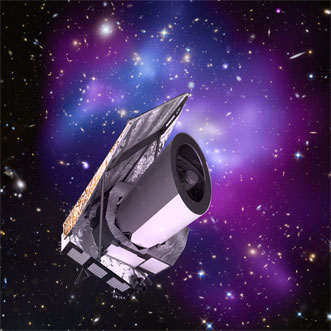
Optical Surfaces Supplies Substrates for Space-Bound NIR Spectrophotometer
Optical Surfaces Ltd. has supplied the Laboratoire d'Astrophysique de Marseille (LAM) with polished substrates to manufacture grisms — or grating prisms — for a near-infrared (NIR) spectrophotometer designed to perform red-shift measurements in the European Space Agency's upcoming Euclid space mission.
The spectrophotometer will make critical measurements on the Euclid mission, according to LAM, and selection of a partner to supply the key optical components for it was a rigorous process.

A rendering of technology being developed for the Euclid space mission, which will study the dark universe. Courtesy of Laboratoire d'Astrophysique de Marseille.
The device design requires four precision grisms mounted on a wheel to allow measurement of galaxy red shifts in two spectral bands: 0.92 to 1.3 μm and 1.25 to 1.85 μm. Each grism is made of a 140-mm Suprasil 3001 prism, manufactured from a 150-mm parallel plate onto which a grating is etched on the polished face.
"Apart from high surface accuracy (<10 nm rms), our main challenge was to develop a polishing method to routinely achieve the extremely demanding near-zero subsurface damage required by the project," said Aris Kouris, sales manager for Optical Surfaces. "In order to achieve this, the surfaces had to be kept completely clean and free of contamination while at the same time be kept virtually scratch-free with a microroughness well below 1 nm rms.
"We found that any deviation from the required cleanliness and surface quality/roughness resulted in nonperfect surfaces after chemical etching, even if the surfaces look 'perfect' prior to etching. It proved that only on virtually perfect surfaces could LAM make a grating to the standards that they require."
LAM, an astrophysics public research institutes in France, combines fundamental research in astrophysics and the development of instrumentation for space and ground-based telescopes. The ESA's Euclid space mission will study the dark universe. One of the on-board probes will be a baryonic acoustic oscillations (BAO) device which will measure the red shift of millions of galaxies through their NIR spectra. The NIR spectrophotometer instrument that forms part of the BAO has been designed to use low-resolution grisms in slit-less mode to perform this massive red-shift measurement.
Optical Surfaces produces optical components and systems, specializing in space and ground-based telescope applications.
/Buyers_Guide/Optical_Surfaces_Ltd/c10918